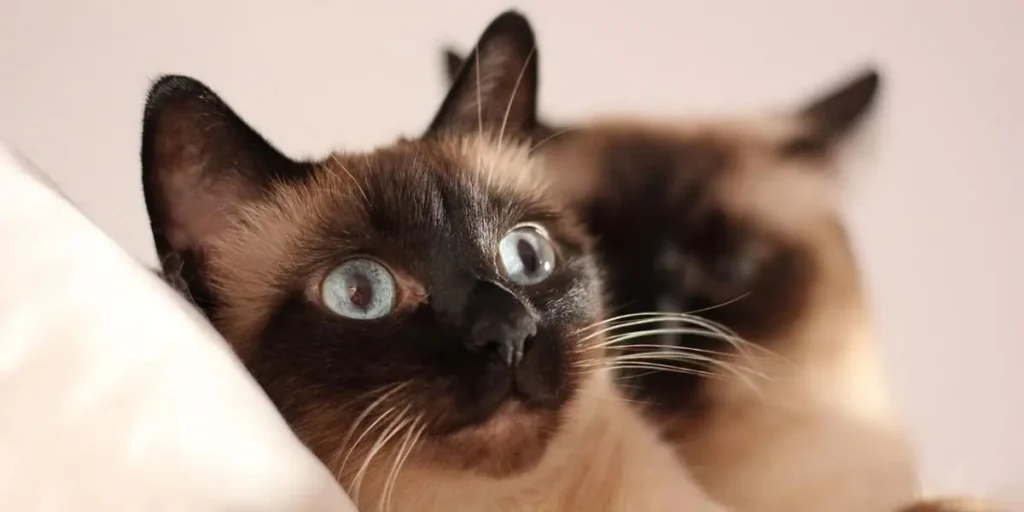Table of contents
Breed History
The origins of the Siamese cat trace back to the 15th century, or even the 14th, according to manuscripts discovered in Ayutthaya, the capital of the Siam kingdom (now Thailand). German zoologist Peter Simon Pallas (1741–1811) also described cats with features similar to the Siamese found in Asia during that era.
Two Siamese-like cats were presented at the Great Exhibition at London’s Crystal Palace in 1871. In 1885, a pair named Pho and Mia drew attention. They belonged to the sister of Major Gould, the British consul in Bangkok, who brought them from Thailand as a gift.
Recognized four years later, the breed grew in popularity between the world wars. The first Siamese cats were mainly seal points, but chocolate, blue, and lilac points soon appeared.
On both sides of the Atlantic, breeding trends diverged slightly. U.S. breeders emphasized body elegance and head length, while British breeders favored larger, lower-set ears and a more oriental eye shape.
Several other cat breeds originated from the Siamese, including the Balinese, Himalayan, Havana Brown, Oriental, and Mandarin. The Fédération Internationale Féline (FIFé) officially recognized the Siamese in 1945.
Physical Characteristics
- Body: Elegant, fine-boned, and muscular with a long, slender neck and legs; oval-shaped paws.
- Coat: Short, glossy, silky to the touch, lying flat without undercoat.
- Color: All colorpoints are accepted—mask, ears, legs, and tail contrasting with the lighter body.
- Head: Wedge-shaped, triangular face; fine muzzle; straight profile; strong chin.
- Eyes: Almond-shaped, deep blue, with a distinctly oriental look.
- Ears: Large, wide at the base, following the triangular head shape.
- Tail: Long, thin, tapering to a point, in harmony with the body length.
Temperament and Personality
The Siamese cat’s behavior often swings to extremes. It can be affectionate and gentle one day, and moody or demanding the next. Highly vocal, this breed is not shy about expressing its needs, which can sometimes be overwhelming.
Nonetheless, the Siamese makes a delightful companion, deeply attached to its owner and eager to follow them everywhere. Sporty and energetic, it requires regular stimulation through play, interactive toys, and climbing structures such as a tall cat tree.
Sociable with a strong personality, the Siamese dislikes loneliness. Combined with boredom, solitude may trigger destructive behaviors.
Living Conditions
The Siamese adapts well to most living environments, as long as it has stimulation and safe freedom of movement. It thrives in apartments if kept active and allowed to explore. The breed also needs a quiet, clean space to retreat when it wants solitude.
Health
Though generally healthy, the Siamese is predisposed to certain conditions:
- Amyloidosis: Protein deposits that disrupt organ function, often affecting kidneys and liver, and linked to feline diabetes.
- Aortic stenosis: A congenital heart defect where narrowing hinders blood flow into the aorta.
- Hypoallergenic breed: No.
Life Expectancy
The Siamese cat typically lives between 15 and 21 years.
Care and Grooming
Siamese grooming is relatively simple, requiring weekly brushing to maintain coat health and reduce hairballs. Other routine care includes trimming claws, cleaning eyes and ears, and occasional bathing with cat-appropriate shampoo if accustomed from youth.
Price and Budget
| Category | Minimum | Maximum |
| Purchase Price | $600 | $1200 |
| Annual Care Cost | $500 | $800 |
Diet
The Siamese diet is similar to that of other cats, with a meat-based focus. High-quality animal proteins are essential. Kittens especially need sufficient phosphorus, calcium, and vitamin D for healthy skeletal development.
Similar Breeds
Balinese, Thai, Ocicat, Oriental, Tonkinese, Snowshoe.


